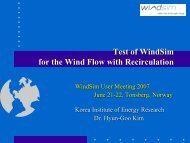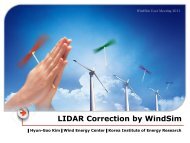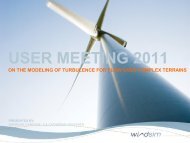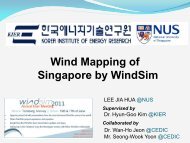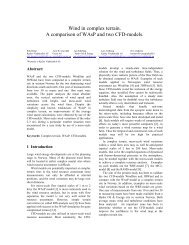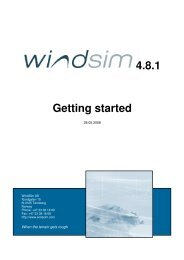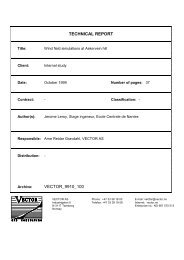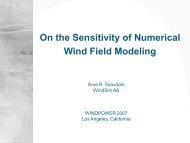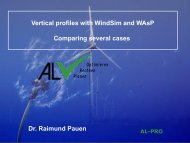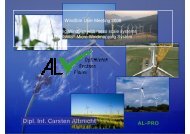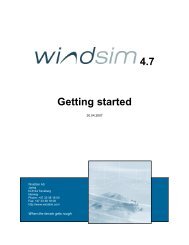wind energy resource evaluation in a site of central italy ... - WindSim
wind energy resource evaluation in a site of central italy ... - WindSim
wind energy resource evaluation in a site of central italy ... - WindSim
You also want an ePaper? Increase the reach of your titles
YUMPU automatically turns print PDFs into web optimized ePapers that Google loves.
1.5.2 WINDFIELDThe W<strong>in</strong>dfield module calculate the <strong>w<strong>in</strong>d</strong> characteristics <strong>of</strong> the <strong>site</strong> <strong>of</strong> <strong>in</strong>terest. To dothis the Reynolds Averaged Navier-Stokes equations are solved, us<strong>in</strong>g the f<strong>in</strong>itevolume numerical method with the CFD solver “PHOENICS”In this module the boundary conditions, the turbulence model and the solversett<strong>in</strong>gs can be def<strong>in</strong>ed by the user.Boundary conditionsThe <strong>w<strong>in</strong>d</strong> velocity vertical pr<strong>of</strong>ile must be set by def<strong>in</strong><strong>in</strong>g the height <strong>of</strong> the ABL, thefree stream velocity <strong>of</strong> the geostrophic <strong>w<strong>in</strong>d</strong> and the <strong>w<strong>in</strong>d</strong> direction. The ABL isdescribed through the log law (refer to chapter 1), while the <strong>w<strong>in</strong>d</strong> direction can beset by subdivid<strong>in</strong>g the <strong>w<strong>in</strong>d</strong> rose <strong>in</strong> a specific number <strong>of</strong> sector, usually 12 <strong>in</strong> order toobta<strong>in</strong> a ma<strong>in</strong> <strong>w<strong>in</strong>d</strong> direction every 30 degrees.In this way, 12 CFD simulations <strong>of</strong> the flow field are needed, <strong>in</strong> which the sett<strong>in</strong>gs forthe ABL are kept constant.The geometrical model <strong>of</strong> the flow field can be considered as a rectangular <strong>w<strong>in</strong>d</strong>tunnel, with one <strong>in</strong>let section and one outlet section. At the ground <strong>of</strong> the <strong>w<strong>in</strong>d</strong>tunnel the <strong>in</strong>formations on the digital terra<strong>in</strong> map are given (chapter 6.2.1), while atthe top <strong>of</strong> the model the “wall with no friction” condition is assigned.Concern<strong>in</strong>g the choice <strong>of</strong> the <strong>w<strong>in</strong>d</strong> vertical pr<strong>of</strong>ile, the value 500 m is given to theheight <strong>of</strong> the ABL. This value is the most used by scientists accord<strong>in</strong>g to literature <strong>in</strong>order to describe the height <strong>of</strong> the geostrophic <strong>w<strong>in</strong>d</strong>; concern<strong>in</strong>g to the choice <strong>of</strong> thefree stream velocity, the value used <strong>in</strong> this CFD simulation is the result <strong>of</strong> the testreported <strong>in</strong> the chapter 5, where 20 m/s was the best value to avoid convergenceproblem <strong>in</strong> a such complex <strong>site</strong>.Turbulence modelThe turbulence model chosen to run the CFD simulation was the default standardκ−ε model. In W<strong>in</strong>dSim, it is possible to def<strong>in</strong>e other turbulence models, like the9




